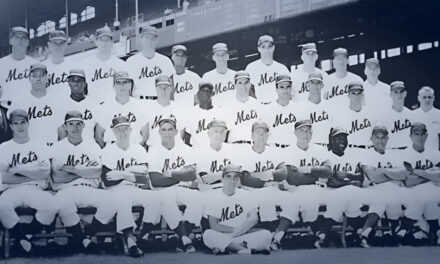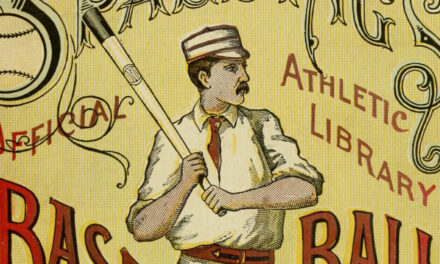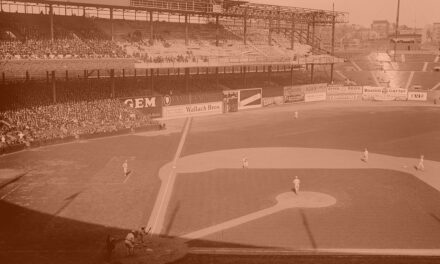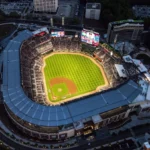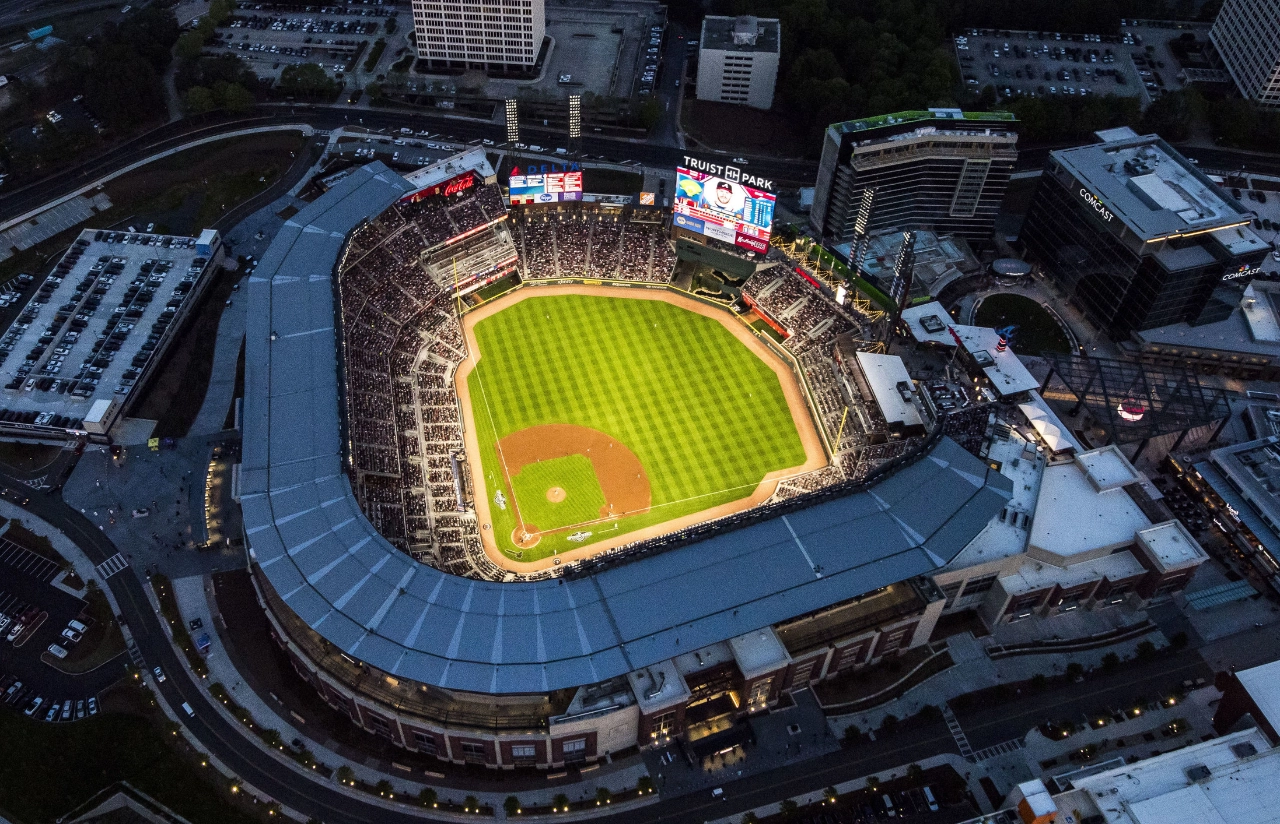
MLB Expansion and Team Relocations 1876 to the Present
For most of its history in the “modern era” (from 1901 on), Major League Baseball has been synonymous with the National and American Leagues. The composition of the two leagues remained relatively static for the first six decades of the 20th century. Each league fielded eight teams, although several franchises relocated from one city to another.
MLB expansion began in the early 1960s with two new teams in each league. Four more rounds of expansion followed until the present total of 30 teams was reached in 1998. With expansion came more team relocations as well as league realignments. Talk persists that additional expansion may be coming.
But other expansions—and contractions—of the professional game occurred early in its history. As of 1968, MLB also recognizes four other professional leagues as major leagues. Three came and went before 1900: the American Association (1882–1891), the Union Association (1884), and the Players’ League (1890). The fourth, the short-lived Federal League, operated in 1914–1915.
In 2020, Major League Baseball recognized seven Negro Leagues as major leagues. Those seven leagues operated at various times from 1920 until soon after integration of the major leagues began in 1947. By definition and intent, the Negro Leagues were entirely separate from Major League Baseball at the time they operated and are beyond the scope of this article.
Major League Baseball Before 1900
Four major leagues engaged in professional baseball competition in the last quarter of the 19th century. The only one that survived into the 20th century, the National League, was the first one founded. But a number of franchises moved from one league to another, and so did individual players.
1876: The National League Is Founded—The First Major League
The National League was founded in 1876 with eight teams, including franchises in Boston (the Reds, now the Atlanta Braves) and Chicago (the White Stockings, now the Cubs) that are still part of the league today. For the next quarter of a century, the configuration of the league changed almost annually as new teams were added and others dropped out. A total of 27 different franchises participated in the league from 1876 through 1891, although there were never more than eight teams in the league in any one year up to that point.
1882–1891: The American Association Competes with the NL
The most significant competitor of the National League was the American Association, which fielded its first teams in 1882 and continued in operation for 10 seasons. The two leagues competed in an early version of a World Series for seven years, 1884–1890.
In its first season, the AA comprised teams in six cities—Allegheny City, Baltimore, Cincinnati, Louisville, Philadelphia, and St. Louis—none of which had NL franchises at the time. In most of the remaining years, the league fielded eight or nine teams, although 13 teams competed in 1884. As in the National League, there was turnover among the franchises, with 25 different franchises representing 19 cities in the course of the league’s existence.
The American Association promoted itself as a less conservative version of professional baseball than the National League. The AA offered lower ticket prices, Sunday games, and alcoholic beverages to its fans. Some NL owners referred to the newer league as the “Beer and Whiskey League.”
Between 1887 and 1890, four American Association franchises decamped to the National League. The league-jumpers included two of the AA’s charter members: Allegheny City, which made the switch in 1887, and Cincinnati, which followed in 1890. The other two were Cleveland, which transferred in 1889 after only two years in the AA, and Brooklyn, which left after six seasons in the league.
1884: The Upstart Union Association Barely Makes It Through the Season
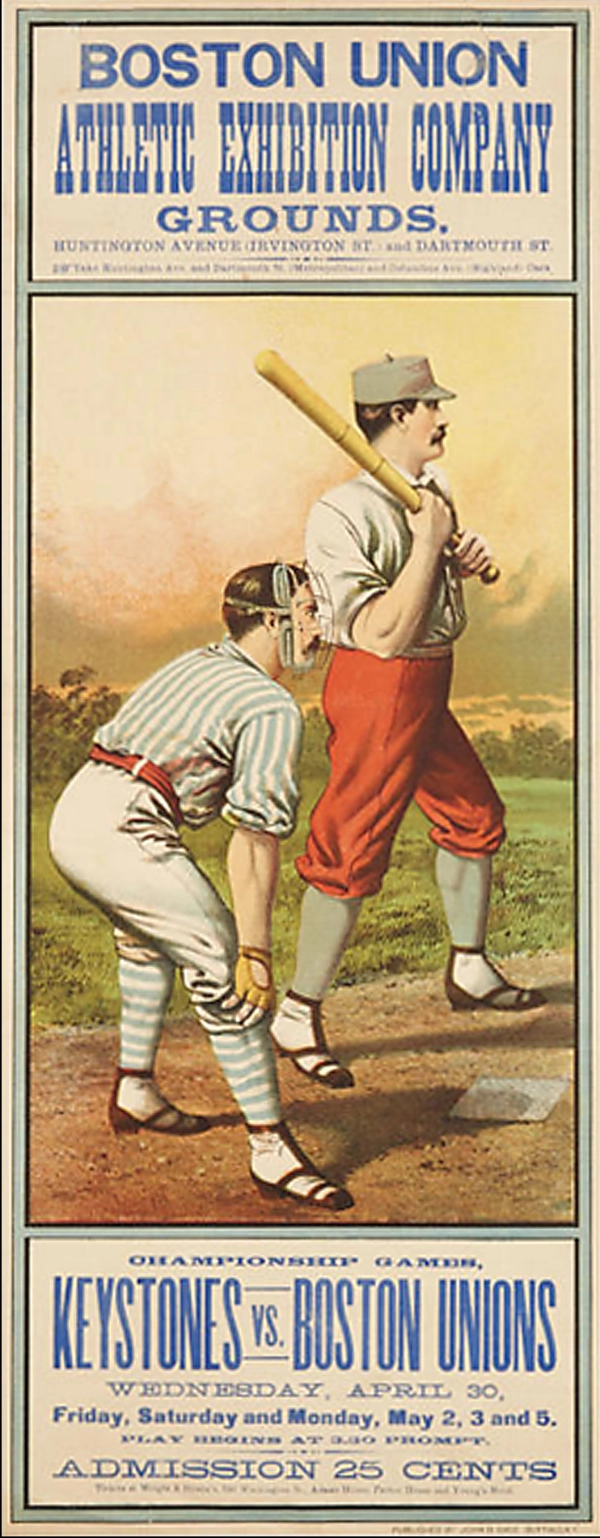
Advertising poster for the Union Association game between the Philadelphia Keystones and the Boston Unions (Reds), April 30, 1884. (Artist unknown, Public domain, via Wikipedia)
A third league, the Union Association, joined the major league ranks in 1884. The league was the brainchild of St. Louis millionaire Henry Lucas, who ran both the league and its best team, the St. Louis Maroons. However, he all but guaranteed the league’s failure by buying up all of the best available players for his own team.
The league began the season with eight teams, seven of which were in cities that already hosted one or more major league franchises. When three of the UA teams folded in the course of the season, new teams were added to complete their schedules. One of the new teams folded too.
Lucas’s St. Louis team clinched the pennant five weeks before the end of the season. The quality of play demonstrated by the other Union Association teams was poor (to the point where some baseball historians question whether it should be counted as a major league), and when the season ended, the league was disbanded. The Maroons joined the National League for two seasons, but all the other teams were disbanded along with the league.
1890: Players Start the Players' League over a Pay Dispute
1890 saw the debut—and demise—of another major league, the Players’ League. The PL was formed by the Brotherhood of Professional Base Ball Players in an effort to escape the National League’s restrictive reserve clause and the salary caps imposed on players by both the National League and the American Association. Many of the the best professional players, including future Hall of Famers, jumped to the new third league.
The Players’ League comprised eight teams, including teams in six National League cities, two of which, Brooklyn and Philadelphia, had American Association teams as well. The quality of play in the Players’ League was generally quite high, but the league was under-funded and folded after one season. Two of the teams, the Boston Reds and the Philadelphia Athletics, joined the AA for the 1891 season, but folded along with that league after the season. The Brooklyn, Chicago, New York, and Pittsburgh franchises were merged into their counterparts in the National League.
1892: The National League Expands to 12 Teams
In 1892, the National League expanded to 12 teams with the addition of four more teams from the American Association, which had disbanded after 10 years. The new franchises were the Baltimore Orioles, the Louisville Colonels, the St. Louis Browns, and the Washington Senators. So, along with the four AA teams that had switched leagues in earlier years, eight of the teams in the 12-team National League had their origins in the American Association.
With former AA teams making up two-thirds of the league, the 12-team National League of the 1890s was in a real sense an amalgam of the NL and the AA. The 12-team configuration remained stable from 1892 through the 1899 season, with no competition from other leagues.
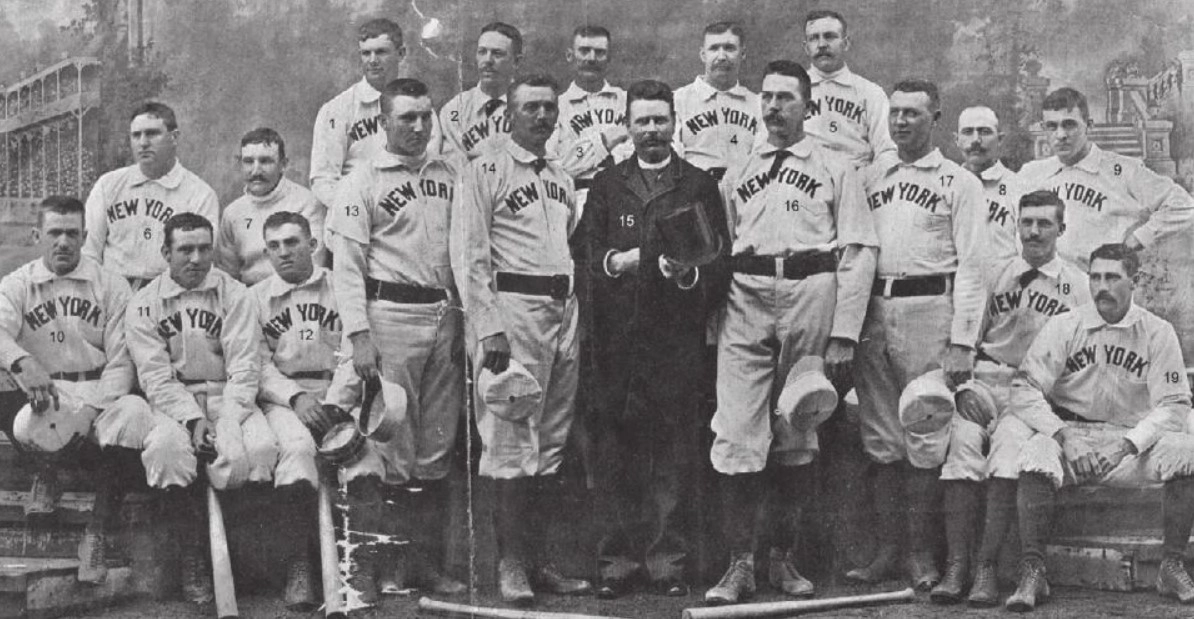
The 1890 New York Giants of the National League. The pictured players include three future Hall of Famers: Mickey Welch, Jesse Burkett, and Amos Rusie (second through fourth from left in the first row). (Inventing Baseball (2013), p. 226., Public domain, via Wikimedia Commons)
1900–1961: The National League's 8 'Classic' Teams
In 1900, the National League contracted again, back to eight teams. The league roster included the two original NL franchises from 1876, Boston (the team had no nickname that year) and Chicago (now known as the “Orphans”), and the two “younger” original NL franchises from 1883, the New York Giants and the Philadelphia Phillies. The other four league members were teams that had joined the NL from the the American Association: the Brooklyn Superbas (later to become the Dodgers), the Cincinnati Reds, the Pittsburgh Pirates, and the St. Louis Cardinals (formerly the Browns).
The four other franchises that had originated in the American Association were left out of the new National League configuration. Three of the cities that hosted these franchises—Baltimore, home of the Orioles, Cleveland, home of the Spiders, and Washington, home of the Senators—ended up with replacement franchises in the new American League the following year. Only Louisville, home of the Colonels, was left without a major league team.
The eight “classic” franchises that made up the National League in 1900 continued to comprise the league for more than 60 years, albeit with some nickname changes and franchise relocations. All eight franchises are still in the league, with five of the eight still in their original locations.
1953: The Braves Move to Milwaukee
The first franchise relocation in the modern National League occurred in 1953 when the Boston Braves moved to Milwaukee. Despite being one of the oldest continually operating franchises in baseball, and despite winning the NL pennant in 1948 behind the pitching of Warren Spahn, the Braves (who had also been known at various times throughout their history as the Red Stockings, the Beaneaters, the Doves, the Rustlers, and the Bees) had become second-class citizens in Boston, where the American League’s Red Sox were far more popular.
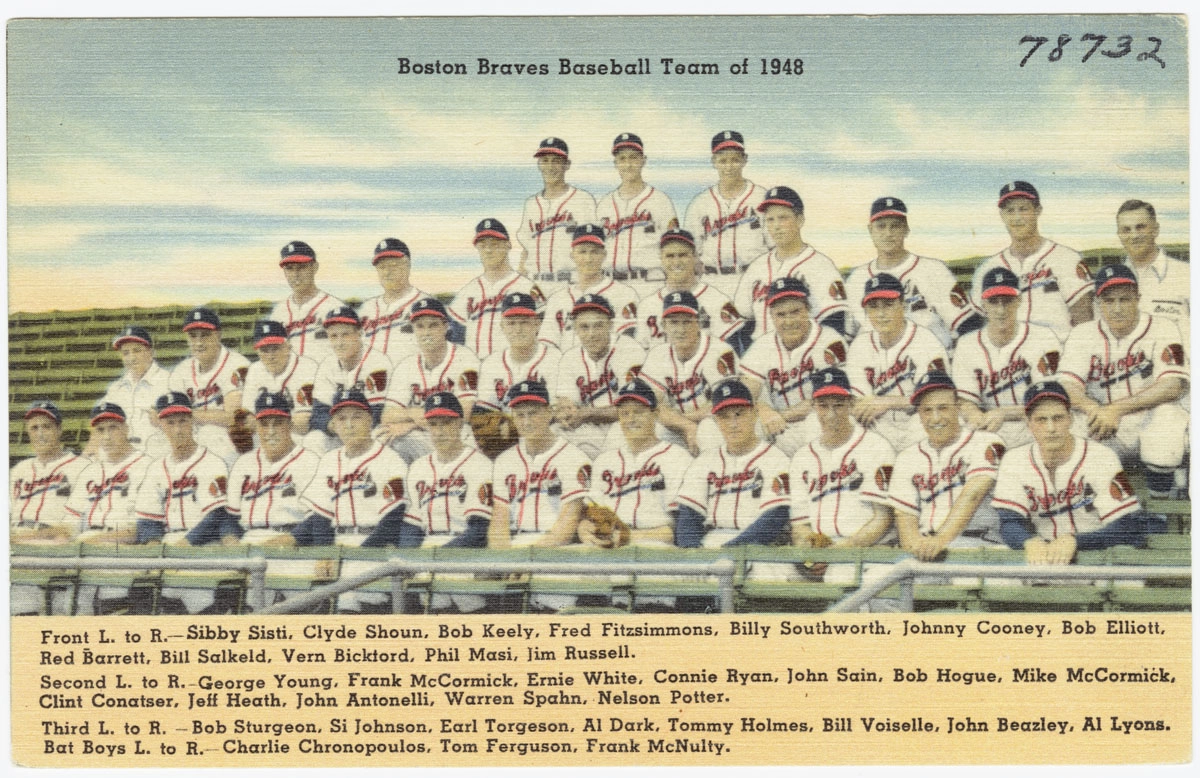
A team postcard of the 1948 Boston Braves. Future Hall of Fame pitcher Warren Spahn is second from right in the second row. (BPL, CC BY 2.0, via Wikimedia Commons)
After moving to Milwaukee, the Braves set a National League attendance record of 1.8 million fans in 1953.
1958: The Dodgers and Giants Go West
The Brooklyn Dodgers first took the field as the Brooklyn Atlantics in the American Association in 1884, before joining the National League in 1890. Known by numerous other nicknames (including the Grays, Bridegrooms, Grooms, Superbas, Trolley Dodgers, and Robins—often simultaneously and interchangeably) for the first 50 years of their history, the Dodgers had a rabid fan base in Brooklyn.
They became the first integrated team in Major League Baseball when they brought African-American player Jackie Robinson to the team in 1947. With Robinson and several other African-American players on their roster, the Dodgers had great success for the next decade. They won 6 pennants and beat the New York Yankees in the 1955 World Series for their first championship.
However, the Dodgers’ stadium, Ebbets Field, was old and in disrepair. Dodgers’ owner Walter O’Malley wanted to build a new stadium in Brooklyn, but he was rebuffed by city planners and politicians. Lured by a lucrative stadium offer in Los Angeles, O’Malley made the unpopular decision to move the Dodgers to the West Coast. He convinced Horace Stoneham, owner of the rival New York Giants (who were also in need of a new stadium), to move west, too.
The Dodgers moved to Los Angeles and the Giants to San Francisco for the 1958 season. For the first time, Major League Baseball was nationwide.
1901–1960: The American League's 8 Charter Members
Meanwhile, the American League began play as a major league in 1901. The new league developed from the Western League, a minor league located primarily in the Midwestern states. Because it came into being a quarter-century after the National League, the American League has often been referred to as the “Junior Circuit,” in contrast to the NL “Senior Circuit.”
Unlike the National League, the American League did not have a salary cap. As a result, many NL players jumped to the AL, including numerous big-name stars. Recognizing that the upstart league was a legitimate competitor, the National League owners reached a “peace agreement” with the American League after the 1902 season. As part of the agreement, the two leagues agreed to play a World Series to determine the overall champion of Major League Baseball.
Like the older league, the AL was composed of franchises in eight cities: Baltimore, Boston, Chicago, Cleveland, Detroit, Milwaukee, Philadelphia, and Washington. It remained an eight-team league for 60 years. The original franchises are all still in the league today, although four of them are no longer in their original cities.
The American League franchise moves are a little more confusing than those of the National League: No National League teams moved until team nicknames were well established, and with the exception of the most recent move in 2005, teams kept their names when they moved. By contrast, several of the American League franchise shifts involved complete name changes and the assumption of names previously used by other franchises.
1902 and 1903: The Milwaukee and Baltimore Franchises Relocate
The American League saw two of its franchises relocate almost immediately. The team in Milwaukee, the Brewers, played only one season in that city before departing for St. Louis in 1902. There, the franchise was renamed as the Browns. The Browns played in St. Louis for 52 years before moving to Baltimore in 1954 to become the Orioles.
Meanwhile, the Baltimore Orioles franchise that was a charter member of the American League moved to New York in 1903. In New York, the team was known as the Highlanders until 1913, when it dropped that name in favor of the New York Yankees.
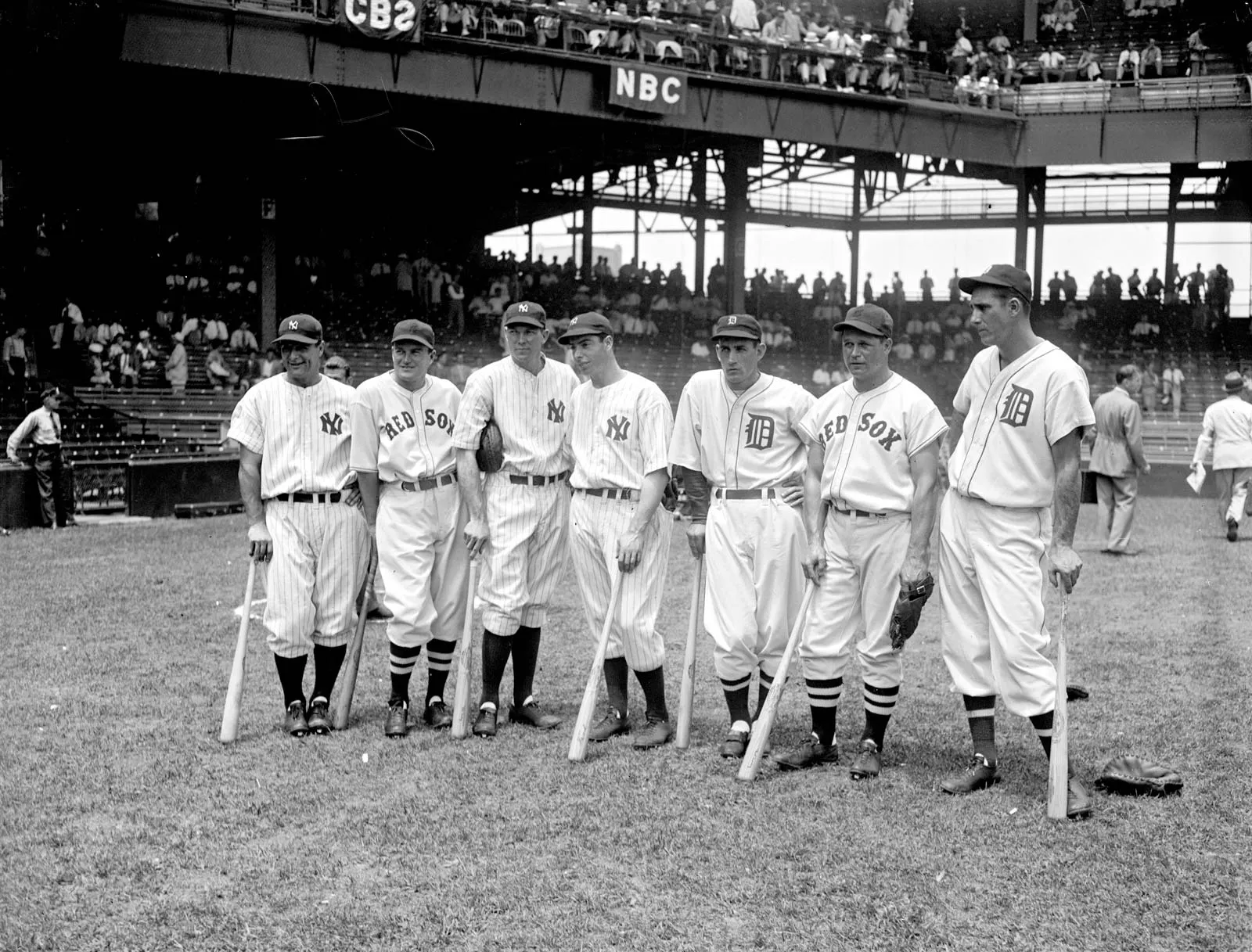
American League All-Stars 1937. Lou Gehrig, Joe Cronin, Bill Dickey, Joe DiMaggio, Charlie Gehringer, Jimmie Foxx, and Hank Greenberg at the All-Star Game in Griffith Stadium, Washington, D.C. (Harris & Ewing/Library of Congress, LC-H22- D-1887)
1954 and 1955: St. Louis and Philadelphia Lose Their AL Teams
With some additional nickname changes, the eight American League teams remained in place from 1903 until the Browns’ move to Baltimore in 1954. Another change came in the following year, when the Philadelphia Athletics moved to Kansas City.
1954: The Browns Move to Baltimore. Despite typically having mediocre on-field results, the St. Louis Browns were for 20 years considerably more popular than the National League’s Cardinals, with whom they shared their stadium, Sportsman’s Park. In 1926, however, the Cardinals beat the Yankees in the World Series, and St. Louis fans embraced the Cardinals at the expense of the Browns.
The Browns regained some popularity in the early 1950s under their new owner, the showman Bill Veeck, but when the Cardinals were sold to brewing giant Anheuser-Busch, Veeck sold the Browns to a group that moved them to Baltimore. They began a new life as the Baltimore Orioles in the 1954 season.
1955: The Athletics Move to Kansas City. The Athletics were managed by the legendary Connie Mack for the first 50 years of their existence and reached the World Series eight times through 1931. But by the 1950s, the team had posted consistently poor results for two decades, and the owners decided to move west to Kansas City for the 1955 season.
The 16-Team Major Leagues Before Expansion
1914–1915: The Federal League Challenges the AL and NL
Meanwhile, the only real challenge to Major League Baseball’s hegemony in the modern era (other than the Negro Leagues) had come from the short-lived Federal League that fielded teams for two seasons in 1914 and 1915. After one season of play as a minor league in 1913, the Federal League declared itself a major league outside the rules of the national agreement that had governed Major League Baseball since 1903.
As an “outlaw” league, the Federal League was not subject to the reserve clause or other restrictions of the two established leagues. With its higher salaries, the Federal League attracted a number of the best players from the National and American Leagues, including six future Hall of Famers.
Like the two existing major leagues, the Federal League comprised eight franchises. Four teams were located in cities with existing major league teams: Brooklyn, Chicago, Pittsburgh, and St. Louis. The other four franchises were placed in cities without a current major league club (but all of which had previously fielded teams): Baltimore, Buffalo, Indianapolis, and Kansas City. After the 1914 season, the Indianapolis franchise moved to Newark, giving the league a second team in the New York metropolitan area.
Nonetheless, the new league struggled to compete with the established leagues. Federal League owners filed an antitrust lawsuit against them in federal court, but Judge Kenesaw Mountain Landis (later the Commissioner of Baseball) urged the parties to negotiate instead of rendering a decision. Ultimately, the Supreme Court ruled that Major League Baseball was exempt from the antitrust laws.
But Federal League franchises were failing financially, and time ran out. National and American League owners bought out half of the Federal League teams (Brooklyn, Buffalo, Newark, and Pittsburgh). Two Federal League owners were permitted to buy teams in the older leagues, the St. Louis Browns in the AL and the Chicago Cubs in the NL. The Kansas City Packers went bankrupt, and the Baltimore Terrapins folded after pursuing an unsuccessful lawsuit.
The Federal League represented the last major league to have teams outside the established National and American Leagues take the field. Future expansion of the major leagues would come within Major League Baseball itself.
1959–1960: The Proposed Continental League Prompts Major League Expansion. In 1959, after the Dodgers and Giants abandoned New York City to move to the West Coast, New York attorney William Shea headed an effort to create a third major league, the Continental League. Eight franchise locations were proposed: Atlanta, Buffalo, Dallas-Fort Worth, Denver, Houston, Minneapolis-St. Paul, New York, and Toronto.
The National League and American League owners were hostile to the idea of a third league. Instead, they announced plans to expand by creating two new teams in each league, and the Continental League disbanded. Ultimately, of the eight cities proposed for Continental League clubs, seven received new or relocated MLB franchises. To date, only Buffalo has not been awarded a franchise.
1961: MLB Expansion Begins with 2 New American League Teams
The National League and American League owners were hostile to the idea of a third league. Instead, they announced plans to expand by creating two new teams in each league, and the Continental League disbanded. Ultimately, of the eight cities proposed for Continental League clubs, seven received new or relocated MLB franchises. To date, only Buffalo has not been awarded a franchise.
In 1960, the American League voted to expand to 10 teams. Prompted by the success of the Dodgers’ and Giants’ moves to the West Coast, the American League added a new franchise, the Angels, in Los Angeles. The league also awarded a franchise to Minneapolis-St. Paul, but Calvin Griffith, the owner of the Washington Senators, asked for and received approval to move the Senators there instead, giving the new expansion slot to Washington.
As a result, the 1961 American League season included two new expansion teams—the Los Angeles Angels and the Washington Senators—and one relocated team, the newly rechristened Minnesota Twins, formerly the old Senators.
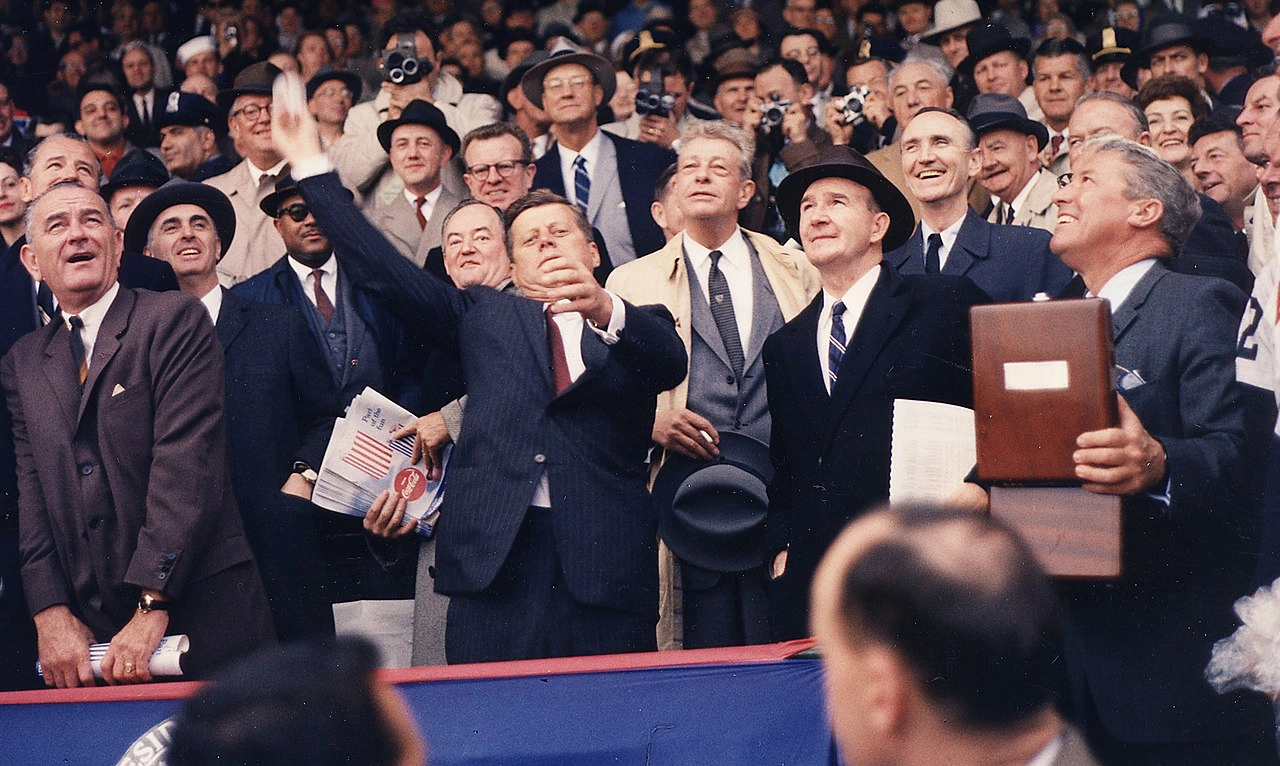
President John F. Kennedy throws out the first ball on Opening Day 1961, as the expansion Washington Senators take on the Chicago White Sox. The Senators lost to the Chicago White Sox 4-3. (Robert LeRoy Knudsen, Public domain, via Wikimedia Commons (cropped photo)
The Angels went through several name changes and stadium changes in their first few years. In their inaugural season, they played at Wrigley Field in Los Angeles, which had been the home of the minor league Angels of the Pacific Coast League. In 1962, they moved to Dodger Stadium (although they called it “Chavez Ravine Stadium”) and played there for four seasons. In 1965, anticipating their move out of Los Angeles the following year to a new stadium in nearby Anaheim, they changed the team name to the California Angels, a name they kept for three decades.
Although the Angels have kept the nickname “Angels” and played in the same stadium in Anaheim since 1966, more variations on the team name followed in subsequent years. For eight seasons, from 1997 to 2004, the team was known as the Anaheim Angels. Then from 2005 to 2015, the team became the Los Angeles Angels of Anaheim. Finally, in 2016, the franchise reverted to its original name, the Los Angeles Angels.
1962: The National League Expands to 10 Teams
Not to be outdone, and having faced the potential threat of the Continental League bringing a team in New York to replace the Giants and Dodgers, the National League added two expansion clubs for the 1962 season—the New York Mets and the Houston Colt .45s.
The New York Mets were formed with the specific intent of drawing fans of the National League’s former New York teams. Their team colors were Dodger blue and Giants orange. In the expansion draft, the Mets selected several players with ties to the old teams, especially the Dodgers. Their home for their first two seasons was the Polo Grounds, the former home of the Giants. See The Amazin’ 1962 New York Mets.
The National League also awarded a franchise to Houston, opening the Texas market to Major League Baseball for the first time. For its first three years, the team was known as the Colt .45s. In 1965, the Colt .45s became the Astros when they moved into the Astrodome, the first domed sports stadium in the world.
1966 and 1968: The Athletics and Braves Move Again
The frachise relocations and league expansions of the late 1950s and early 1960s opened up new horizons for Major League Baseball, and further changes were soon in the works.
The Braves Move South: 1966 brought another franchise shift as the Braves left Milwaukee after 13 seasons in the Midwest. The Braves relocated to Atlanta, becoming the first Major League team in the Southeast.
The Athletics Move West Again: California gained its fourth major league team in 1968, when the Kansas City Athletics completed their westward migration, which had started when they relocated from Philadelphia, by moving to Oakland.
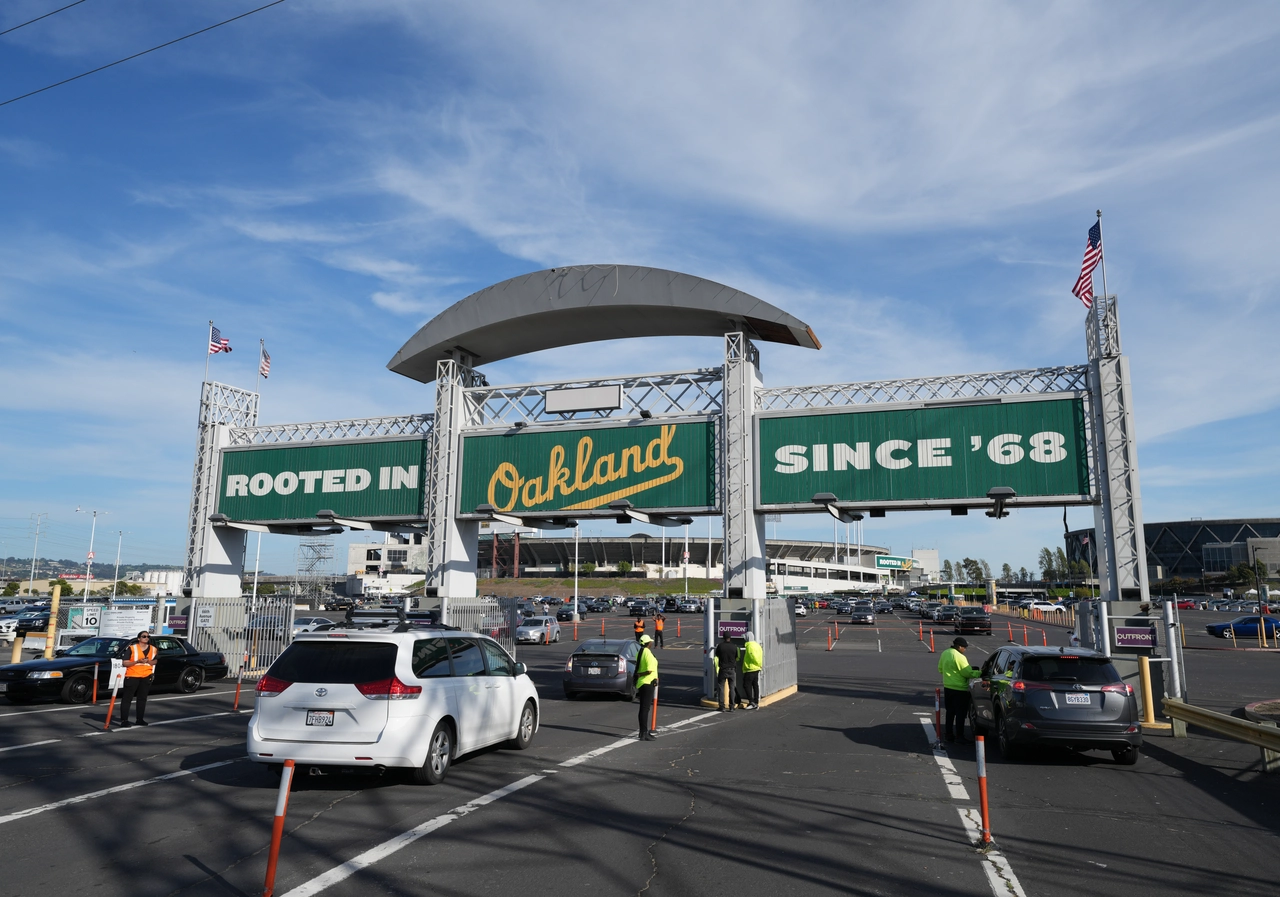
A sign at the entrance to the Oakland Coliseum says the A's have been "Rooted in Oakland since '68." Oakland was the franchise's third location, after moving first from Philadelphia to Kansas City. As of 2025, the team is no longer "rooted in Oakland," moving temporarily to Sacramento on the way to a new permanent home in Las Vegas. (Quintin Soloviev, CC BY-SA 4.0, via Wikimedia Commons)
1969: MLB Expansion Adds 4 Teams and Reaches Canada
Further expansion was also on the agenda. In 1967, both leagues voted to add two more teams for a total of 12 teams in each league. When the Athletics moved to Oakland for the 1968 season, the expansion timetable was moved up. Instead of beginning play in 1971 as planned, the new teams took the field in 1969.
The AL Adds Kansas City and Seattle: The American League replaced the Athletics with the expansion Kansas City Royals and added a new West Coast team, the Seattle Pilots. Unfortunately, the Pilots were unsuccessful on the field and were in financial trouble from the start. Major League Baseball approved a sale of the team and a move to Milwaukee for the 1970 season, where the team was reborn as the Milwaukee Brewers. So, four years after the Braves had left for Atlanta, baseball was back in Milwaukee.
The NL Expands to San Diego and Montreal: Meanwhile, the National League expanded into two new markets for the 1969 season. The senior circuit added a third California team, the San Diego Padres. And in baseball’s boldest move yet, the league expanded internationally by adding the Montreal Expos as the first major league team in Canada.
1972: Washington’s Loss Is Texas’s Gain: Soon after this round of expansion, the American League approved one more relocation: In 1972, the Washington Senators (the 1961 expansion version) moved to Dallas-Ft. Worth, giving both leagues a presence in the Lone Star State. The team was renamed as the Texas Rangers. Meanwhile, for the first time in the 20th century, the national’s capital was without a major league team, a situation that would not be remedied until 2005.
Divisional Play Begins: In connection with the 1969 expansion, the leagues created divisions for the first time, resulting in a new round of playoffs to decide the pennant winners. Each league was divided into two divisions, East and West, with six teams in each division. Although new teams and realignments would alter the divisions in the coming years, the East-West divisional setup remained in place through 1993.
1977: The American League Expands to 14 Teams
In 1977, the American League expanded again, going from 12 teams to 14 teams. The league added its first franchise in Canada, the Toronto Blue Jays, to compete with the Montreal Expos of the National League. The Pacific Northwest also received a new franchise, the Seattle Mariners, to replace the ill-fated Pilots of 1969.

A ticket for the expansion Toronto Blue Jays Opening Game on April 7, 1977. The Blue Jays beat the Chicago White Sox 9-5. (Toronto Blue Jays / Kerr-Progress/Cambridge, Public domain, via Wikimedia Commons)
With the 1977 expansion, the existing East and West divisional structure was maintained. Each division was increased from six to seven teams: Toronto was added to the East Division, while Seattle joined the West Division. This alignment was maintained for 17 years, through the 1993 season.
1993: The National League Expands to 14 Teams
Despite the AL expansion in 1977, the National League remained at 12 teams until 1993, when it added two new franchises of its own. Both of these teams represented forays into new, formerly untapped markets. The Colorado Rockies, based in Denver, were marketed to the vast Mountain States area between Kansas City and California. The Florida Marlins, located in Miami (and known as of 2012 as the Miami Marlins), were the first Major League team in the Sunshine State.
For the 1993 season, the league retained its existing divisional structure, adding Florida to the East Division and Colorado to the West.
1994: The Leagues Switch to a Three-Division Format
With 14 teams in each league, both leagues changed over to a three-division format in 1994, adding a Central Division in each league and realigning the East and West Divisions. In each league, the East and Central Divisions had five teams, while the West Division had four teams.
In order to accommodate the three divisions, Major League Baseball added a new playoff round, the Division Series. Playoff berths would go to the three division winners as well as a Wild Card team, the team with the best overall record that didn’t win its division. The winners of the two Division Series matchups in each league would advance to compete for their league’s pennant in the League Championship Series.
In 1994, the postseason was canceled due to a players’ strike that began in mid-August. As a result, the new playoff structure was not implemented until 1995.
1998: MLB Expansion to 30 Teams Brings More Changes
The final round of expansion to date occurred in 1998, when each league added one new team. The American League moved into Florida with the addition of the Tampa Bay Devil Rays (known as of 2008 as the Rays). The National League moved into the Arizona desert with the addition of the Phoenix-based Arizona Diamondbacks.
The Brewers Switch Leagues. The expansion to 30 teams, with an odd number of teams (15) in each league, created potential scheduling problems. To avoid this, MLB decided to move one team from the American League to the National League, giving the NL 16 teams and the AL 14. The Milwaukee Brewers agreed to transfer. So Milwaukee, the former home of the Braves for 13 years, once again became a National League city, with the Brewers in the NL Central Division.
The Tigers Switch Divisions. The Arizona Diamondbacks were added to the NL West Division, giving the National League five teams in the East Division, six teams in the Central, and five in the West. Meanwhile, to make room for Tampa Bay in the AL East, the Detroit Tigers agreed to move from the AL East to the AL Central Division. The moves resulted in five teams in the AL East, five in the AL Central, and four in the AL West Division.
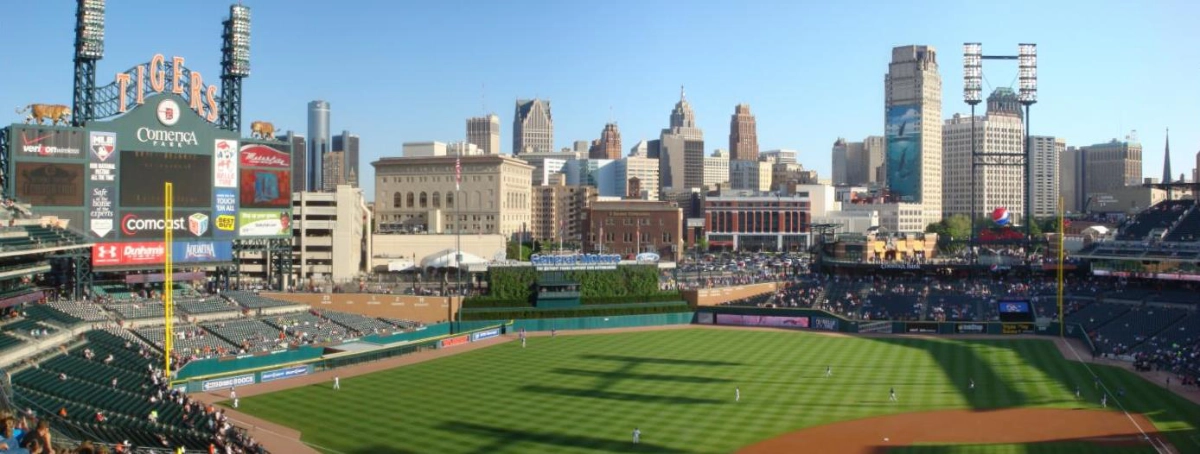
Comerica Park with the skyline of Detroit. After playing in Tiger Stadium for 88 seasons, the Detroit Tigers moved to their new modern ballpark in 2000. (Triphook at en.wikipedia, Attribution, via Wikimedia Commons)
2005: Baseball Returns to Washington D.C. In 2005, there was a move within the National League East: The Montreal Expos franchise relocated to Washington, D.C., where the team was renamed the Washington Nationals. But the unbalanced league alignment was maintained through the 2012 season.
2013: Balanced Alignment Returns
Effective with the 2013 season, the Houston Astros moved from the NL Central Division to the American League West Division, resulting in two 15-team leagues. The move enabled the leagues to balance their divisions for the first time since 1998, with five teams in each division. With each league now fielding 15 teams, the new alignment required additional interleague play.
The Playoff Field Expands. MLB also added a second Wild Card playoff berth in each league in 2012. In order to create an addional incentive for teams to win their division, the new format had the two Wild Card teams—the two non-division winners with the best records—face off in a single “play-in” Wild Card game to determine which one would advance to the Division Series.
In 2019, the postseason was expanded again to include Wild Card berths for the three teams with the best records that do not win their divisions. There are two best-of-three Wild Card Series in each league, featuring the three Wild Card teams and the lowest seeded division winner. The new format was suspended in 2020, when the season was shortened due to the Covid pandemic, but it resumed beginning in 2022.
More Expansion and Relocations Coming?
The Athletics Move Again. The Athletics played their last home games in Oakland in 2024. From 2025 through 2027, the A’s will play their home games in Sacramento, California, before moving to a new stadium in Las Vegas for the 2028 season. This marks the fourth move for the venerable American League franchise, moving it ahead of the Braves for the most often relocated franchise in MLB history.
With the Athletics’ move in the works, will other smaller-market teams also seek greener pastures? It is likely that more changes will come, whether that means relocations or expansion or both.
Most analysts believe that Major League Baseball will expand to 32 teams at least by the early 2030s. There are plenty of candidates among other U.S. cities and metro areas, along with several in Canada and Mexico. Which locations will be chosen remains to be seen.
Copyright © Brian Lokker 2011, 2025. An earlier version of this article was published on HubPages.com in 2011 and was subsequently featured on HowTheyPlay.com.
The featured image is a 2023 aerial view of Atlanta’s Truist Park by Justin Lorenzo, CC BY-SA 4.0, via Wikimedia Commons.

